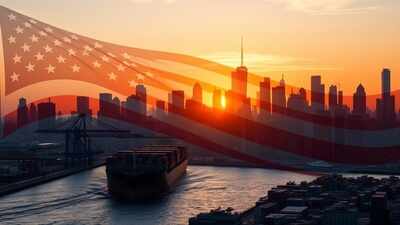
The US economy bounced back in the second quarter of 2025, growing at an annualised rate of 3.0 per cent, reversing a 0.5 per cent contraction seen in the first three months of the year, according to data from the US department of commerce. The stronger-than-expected growth figure was largely driven by a sharp drop in imports, and came amid continued uncertainty over trade policy and its impact on consumer and business behaviour.Following the GDP announcement, US President Donald Trump intensified calls for interest rate cuts. Posting on Truth Social, he wrote: “2Q GDP just out : 3 per cent, way better than expected! ‘Too Late’ Must now lower the rate. No Inflation! Let people buy, and refinance, their homes!”Trump’s push for rate cuts came just hours before the Federal Reserve was scheduled to announce its interest rate decision. He also blamed the Fed Chair, saying Jerome Powell “must now lower the rate.”Economists say the headline figure masks underlying weaknesses. The commerce department noted that the GDP increase was “primarily reflected by a decrease in imports,” which added more than 5 percentage points to growth. As per news agency AP, this was the largest drop in imports since the Covid-19 pandemic and followed a rush by companies earlier this year to stockpile goods ahead of Trump’s proposed tariff hikes.According to Goldman Sachs, the surge in imports during the first quarter had created the biggest drag from net exports on GDP in recorded history. Now, that effect has reversed, but analysts caution it may not be sustainable.While the topline GDP figure painted a strong picture, a core measure that excludes volatile components such as exports, inventories, and government spending slowed to just 1.2 per cent in Q2 from 1.9 per cent in Q1, as per news agency AFP. This marks the weakest underlying growth rate since late 2022.According to AP, nationwide chief economist Kathy Bostjancic said, “Headline numbers are hiding the economy’s true performance, which is slowing as tariffs take a bite out of activity.” She noted that consumer and business spending rose only moderately, as households frontloaded purchases earlier and businesses postponed investments amid policy uncertainty.Private investment plunged at a 15.6 per cent annual rate, the steepest fall since the pandemic, while business inventory levels fell sharply, shaving 3.2 percentage points off the GDP growth. “Companies do not want to invest in equipment, buildings or hiring with this much uncertainty,” said Heather Long, chief economist at Navy Federal Credit Union, as per AFP.Federal spending also declined for a second straight quarter, dropping 3.7 per cent, after a 4.6 per cent fall in Q1.Trump’s approach of using tariffs to restructure trade continues to polarise economists. He has imposed wide-ranging duties, including 10 per cent levies on many trade partners, and higher tariffs on steel, aluminium, and automobiles. These also targeted countries like Canada, Mexico, and China.Both Washington and Beijing retaliated with tit-for-tat measures, leading to steep duties on each other’s goods. However, following fresh talks in Stockholm this week, negotiators hinted at a possible truce extension, though the final decision rests with Trump.While Trump argues tariffs protect American jobs and industry, critics point out that tariffs raise costs for US importers and potentially stoke inflation. Still, inflationary pressures have eased. The core personal consumption expenditures (PCE) index rose 2.5 per cent in Q2, down from 3.5 per cent in Q1, reported AP.As per AFP, Bernard Yaros of Oxford Economics noted the economy is “switching to a lower gear but not going in reverse.” He believes the Fed can afford to wait before adjusting interest rates, assessing inflation data over the next few months. “Consumers are slowing their spending but not heading for the bunkers outright,” he added.With payroll data showing 104,000 new jobs added in July, analysts suggest that while a recession is not imminent, clarity on trade policy is essential to restore long-term confidence. “There’s no recession in sight, but certainty is needed to get the economy fully back on track,” said Long.







